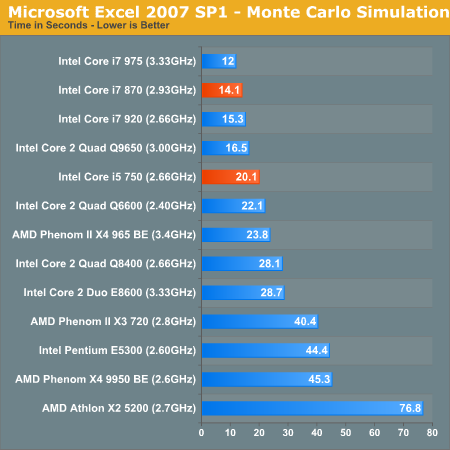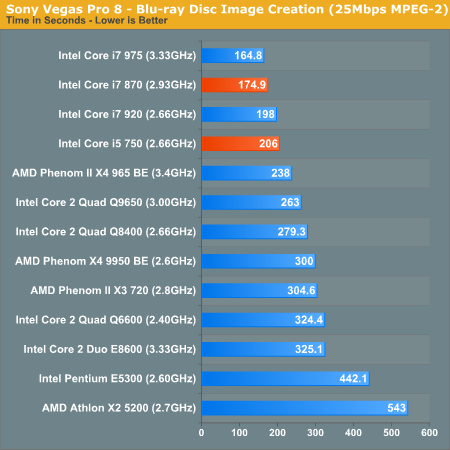Intel's Core i7 870 & i5 750, Lynnfield: Harder, Better, Faster Stronger
by Anand Lal Shimpi on September 8, 2009 12:00 AM EST- Posted in
- CPUs
Microsoft Excel 2007
Excel can be a very powerful mathematical tool. In this benchmark we're running a Monte Carlo simulation on a very large spreadsheet of stock pricing data.

The Excel test is peculiar in its results. It must be one of the few situations where Bloomfield's memory bandwidth advantage is seen as even the Core i7 870 can't outperform the i7 920. The Core 2 Quad Q9650 does well thanks to its large 12MB L2 cache, as does the Q6600 with a beefy 8MB cache.
Sony Vegas Pro 8: Blu-ray Disc Creation
Although technically a test simulating the creation of a Blu-ray disc, the majority of the time in our Sony Vegas Pro benchmark is spend encoding the 25Mbps MPEG-2 video stream and not actually creating the Blu-ray disc itself.

Hyper Threading is good for about 4% here, giving the 920 the slight edge over the Core i5 750.
Sorenson Squeeze: FLV Creation
Another video related benchmark, we're using Sorenson Squeeze to convert regular videos into Flash videos for use on websites.

The i5 750 pays the HT penalty, taking another 20 seconds to render our test video than the i7 920. It is still faster than the Phenom II X4 965 BE at a much lower cost. The Core i7 870 comes close but can't beat the i7 975.










343 Comments
View All Comments
jonup - Tuesday, September 8, 2009 - link
Unfortunately people in corporate world do not make a difference between a HD4500 and a GX790. As lond as the Intel can display spreadsheets its good enough (or better) than a GTX295/HD4890X2, because it is Intel. You can change ignorance when it works.PassingBy - Tuesday, September 8, 2009 - link
My horizons are broad enough, thank you. The needs of many corporate desktops/laptops will be met by Clarkdale/Arrandale and no, nobody will go blind or suffer eyestrain (by virtue of the IGP anyway).PassingBy - Tuesday, September 8, 2009 - link
No edit function, so, as I point out later in the thread, people reading this review presumably won't be interested in IGPs anyway, given that these processors now have no IGP market. Wait for Clarkdale before trying to compare IGPs.dragunover - Tuesday, September 8, 2009 - link
Thanks for the review, if not as soon as I wanted it!Boobs McGee - Tuesday, September 8, 2009 - link
Do you guys have plans to do a motherboard review roundup for P55?If not, please do.
Gary Key - Tuesday, September 8, 2009 - link
I actually have three roundups planned, we have 15 boards here ranging from the $100 uATX items up to the $300 EVGA Classified series. We are only testing with retail products, released BIOS', and retail processors so the delivery of more than 70% of the boards late last week has created a small logjam. ;)The first article should be up on Thursday with a couple of my favorite boards and then a rather large one up on Monday and the last one a few days after that. Raja is working on a separate roundup of the top three boards targeted for the more extreme OC community. We will also have a P55 memory specific article shortly.
ClagMaster - Tuesday, September 8, 2009 - link
Looking forward to reading these P55 motherboard roundups.Anand Lal Shimpi - Tuesday, September 8, 2009 - link
Yes, Gary is nearly complete with his. Give him another day and it'll be up :)Take care,
Anand
Comdrpopnfresh - Tuesday, September 8, 2009 - link
By creating a new socket- they're providing a disincentive for early adopters of bloomfield. This chip is literally a humpty-dumpty that stands to benefit intel with everyone suffering a small loss of their own. The benefits of lynnfield vs bloomfield come from shuffling the architectural deck of nehalem. In reality, it only shows the possibilities of an inflexible architecture.The turbo mode isn't cutting it in day-to-day power consumption reduction. On the scale of a day, the average shmoe who is ass enough to leave a computer on for no reason gains no benefit. Lower the reach of a voltage plane, and reduce the number of components sucking juice, that only present benefits under certain situations (a third memory channel), and shmoe is happier.
If it was in the article, I apologize, but with the pci-e controller being on the un-core... what happens on a chipset with integrated graphics? Will the igp be linked to the processor now, rather than a bridge chip? If ati or nvidia made their own supporting chipsets with an igp- would the igp represent a chip onto itself, solely connected to the cpu, or would it have to work through dmi, and leave those on-die pci-e lanes for domestic usage?
It seems this is the warning rattle to nvidia that they chose their place with ion, and are stuck in it. When the change to 32nm comes, and the gpu is integrated into the cpu- what kind of robust 3rd party chipsets could exist in the budget end? Sure, you can always add a dedicated, off-die, gpu... but for budget boards used to eons of making room for a cpu and working a bridge chip around an igp- either horrible inefficiencies will creep up, or higher prices.
My money is on westmere having at least three power planes.
I'd like to know: with the pci-e controller on-die now... what impact this puts on graphics cards with higher on-card memory. Does it strengthen or minimalize it?
And, can the cpu now share the gpu's memory as a way to extend cache- after years of being forced to share the system pool. That 16gb/s link to gddr5 looks mouthwatering. I'd like to see performance tests run with the pci-e varient ssds floating around out there saddled to the on-die pci-e lanes, and a graphics card running off of chipset. Rather than elevating a horse-power driven graphics subsystem, I think the benefits of supplying more 'torque' by freeing mass storage ssds from the SATA interface would be far more substantial, and in all applications of the PC. You already have the means for nearly 2+2/3 times the theoretical bandwidth of SATA-6- which up til now seems rather bug-ridden and defunct.
Also interested in the outcomes of usb3 with this- as usb is built on the foundations of pci-e, is it not? If usb3 can allow for pci-e externally, and you remove the latency issue of usb signaling traveling from some peripheral bridge chip to the cpu, and just jack the usb3 communications into the cpu... could one use usb3 as a computer-to-computer psuedo qpi teaming/networking bridge for inter-desktop cpu communication. skip the entire bottleneck of client-level software implementation, and the subsystem communication buses for out-of-box signaling too...
plague911 - Tuesday, September 8, 2009 - link
The market just got a little more crowded so hopefully this will bring a reduction in prices of the 920. but..
“The Core i7 870 gets close enough to the Core i7 975 that I'm having a hard time justifying the LGA-1366 platform at all. As I see it, LGA-1366 has a few advantages:
1) High-end multi-GPU Performance
2) Stock Voltage Overclocking
3) Future support for 6-core Gulftown CPUs
“
Your exactly right 1366 I think is going to be be the best option to “future proof” my system however the new chips make the 920- seem a little low on features. With the goal of “performance on a budget” I feel like we are stuck either getting a board with a socket which wont compete in the future, or chip which is weaker than its lower class cousins. Unfortunately I dont see any of this being fixed in the next few cycles. Id like to see a low clocked gulftown (to save cost) feature rich with good OC potential thats on the lower end of the price scale. To me this would be a good follow up to 920 but but it dosent seem like that will be coming out for several cycles. Unless ofc i'm missing something which is probably the case.